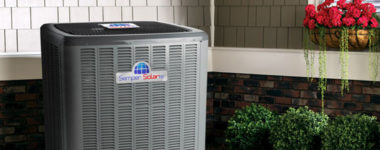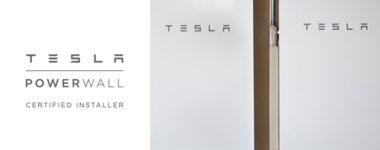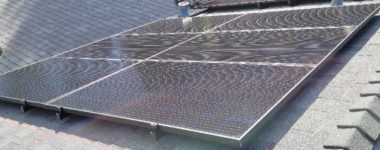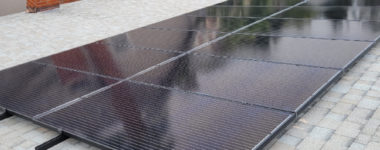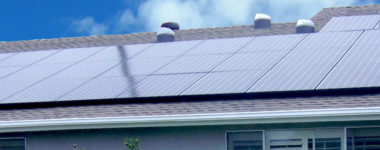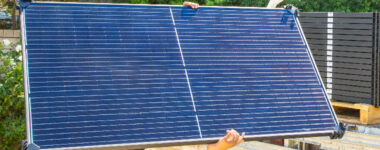Technology | Solar Panels, Battery Storage, Roofing, HVAC
Choosing the right HVAC contractor can be overwhelming. Let's keep it simple. Here are our top 10 factors you should consider when choosing a contractor. Semper Solaris is a locally owned and operated company, and we are known throughout the San Diego area for our stellar service in solar panel installation and roofing. We have made the leap into heating and air conditioning services in Escondido because we see how well an excellent and efficient air conditioner system can pair with solar panels to help you become independent from the grid! Searching for a reputable HVAC contractor can be stressful because you want someone honest, clean, and hard-working. So today, we want to offer some tips on how to look for the best contractor for your heating and air conditioning installation in Escondido! How to choose the right heating and air conditioning contractor: Ask your friends, neighbors, colleagues, and family members for referrals Make sure you check that they have proper licensing and certificates to install the equipment. Look for a license number on their website. The state of California has strict licensing requirements for all HVAC contractors. Look at their customer ratings online. Do most customers have a pleasant experience or are there more bad reviews than good? An honest installer will go over all contracts with you and make sure you get all of your warranty information and a copy of the agreement for your files. Get in writing what dates they plan on working and when the project will be finished. Ask about any federal, state, or local rebates available to you Ask about the payment schedule, and when you need to make the first payment toward the work. Generally, you will make a deposit and pay the balance toward the end. Your contractor will know what HVAC units are available on the market and should be able to offer you information about what models will fit your home and lifestyle best. Remember that they may have insider information on models that have more problems than other ones, so it is a good idea to listen if they try to steer you away from a model you liked. Don't be afraid to ask about special offers and coupons! Many companies offer them. When you schedule an appointment with your potential contractor, they should inspect your home, including the old air conditioning and heating unit, as well as your attic space so they can look at your ducting to make sure it's in good shape. The right contractor will not try to upsell you by encouraging you to buy an air conditioner that is too big for your needs!
Tesla is a leading American company famous for manufacturing electric vehicles. The company is moving forward to bring innovations in other industries. Tesla Powerwall is a step towards this direction. This innovative technology can help to store energy for residential and commercial usages. Tesla Powerwall is a lithium-ion battery that you can use as an alternative to power your home. You can use this as a backup to support your energy needs. This is a wall or floor-mounted battery system designed to store energy generated by wind turbines, solar power panels or the grid (electric company). You can use Powerwall daily to power your home. Each battery can store up to 13.5 kWh of energy, weighs 251.3 pounds, and offers an easy installation. You can install it both inside and outside of your home. However, the installation needs to be done by a certified technician. Semper Solaris is a proud Tesla Powerwall certified installer. How to Use Tesla Powerwall There are three ways to use Powerwall. You can get a complete power source to meet the energy needs of your home. Its off-grid approach will enable users to power their homes fully by using the solar battery storage. You can install one or two Powerwall batteries depending on your requirements. Powerwall can be considered as a supplementary power source for your home during the evening or when you need it most. Powerwall can be ideal for the backup power supply in case of a power outage or blackout. Once installed, it can be accessed through the intuitive, easy to use dashboard. The dashboard gives you control of power being used in your home and allows you to adjust the time and settings of your Powerwall. How Does A Tesla Powerwall Work? Each part of the Powerwall system will be plugged into the electrical panel of your home. The Powerwall will collect and store energy. You will need a setup with a few components, and it will be installed in your house. Powerwall Battery Pack This is one of the crucial components of a system. This pack will merge with your electrical panel to enable you to use the solar storage for emergency or daily use. Solar Panels Solar panels are the best option to convert solar energy into electricity. The solar panel will store solar energy during the day hours to be used at night when solar panels are not receiving sunlight. Inverter The inverter is what will convert solar energy into electricity. With the Tesla Powerwall, the inverter is built into the battery. Backup For the backup usage, you will need to download the Tesla mobile app to view and set up backup for your Powerwall. According to Tesla, “Powerwall is now designed for whole home backup. With whole home backup, your Powerwall system can support your entire home with backup power during an outage.” Tesla Powerwall is supported by ten years warranty. It is designed to offer a worry-free approach to meet the energy needs of your home or office. Charging Your Powerwall Tesla Powerwall is a great way to store any unused energy for future use or emergencies. To use your Powerwall, in any situation, you must charge it. Powerwall and the Grid According to PG&E, battery storage has two main functions, to charge and discharge. Charging can be done through your solar system or through the grid, or the electric company. Discharging is using the stored energy from your battery storage or returning it to the grid. Tesla Powerwall can be installed in your home with or without solar. When Powerwall is installed with solar, it will not be able to be charged from the grid, as it will be charged from the solar panels on your home. When Powerwall is installed without solar, it can be charged from the grid, or electric company, if it is in Backup-Only or Time-Based Control. Backup Only According to Tesla, "Backup power mode or Backup-Only reserves 100 percent of your Powerwall energy to provide seamless power to your home in the event of an outage. Powerwall will charge from the grid or from your solar system, and only discharge during a grid outage." Advanced Time-Based Control Time-Based Control helps you maximize savings by smartly charging or discharging your Powerwall" according to Tesla.
Have you ever been without power in your home when you really needed it? Have you ever had to fumble around your house with a flashlight between your teeth, or to light every candle you own? Or have you ever been without power for so long that you hesitated to open the fridge, not wanting to let any precious cold air out? For those of you that have experienced a power outage, especially a long one, you know exactly how unpleasant it is. Yet, in 2019, power outages will be the price that many Californians will pay in order to help avoid disastrous wildfires. California electric companies have started taking more proactive measures in order to prevent wildfires, like the deadly Camp Fire that killed 85 people in 2018. According to Time, California’s wildfires have only gotten more frequent and more costly in the last few years. Through research and debates, electric companies have discovered that fallen power lines or other electric accidents can be major contributors to these terrible fires. With that in mind, they have decided to implement outages when fire danger is especially high. Californians should expect to see these power outages this summer. When winds are high and humidity is low, electric companies like PG&E are planning to shut off all power to at-risk areas until the danger is lower. PG&E will also specifically be implementing other fire-safety changes like clearing brush and conducting more regular inspections. So what does that mean for the average Californian? In short: more rolling blackouts. Whether you’re under PG&E, Southern California Edison, or Sempra Energy, you can expect your power to be shut off--sometimes for days at a time. This raises an important question: what can you do about it? Of course, there are all kinds of ways to prepare for a blackout. You could stock up on flashlights and candles, or have battery-powered lights easily accessible. You could also keep insulated bags on hand for your freezer food. Remember to keep extra ice packs for your other food in your fridge--and some for yourself, because no power in the hot California summer also means no air conditioning! Finally, whether you’re expecting a blackout or not, it’s always a good idea to keep extra containers of drinkable water on hand. Will My Solar Panels Work in a Blackout? Yes—Through Battery Storage! However, there’s another, much easier way of dealing with an energy shut-off: having your own power supply. When other Californians may be sitting around candlelight, still sweating in the summer nights, you have another option. Californians all over the state are installing solar panels for all kinds of reasons, including saving money on electric bills, “going green,” and increasing home value. One of the most beneficial reasons to install solar panels, however, is having your own power supply when the grid’s power is cut. Solar panel systems can now be installed with battery storage, which means long-lasting energy stored for extra energy or for emergencies such as a power outage. These batteries are connected to your solar energy system and store any extra energy that your system produces. Not only are they great for emergency power shut-offs, but they can also strategically sell back some of that extra energy to the grid during peak hours. This means that your system can save extra energy and money, no matter what your energy circumstances! Semper Solaris Offers the Tesla Powerwall There are several energy storage systems available, though two of the most popular are the Tesla Powerwall and Enphase Encharge Battery. Semper Solaris is proud to carry both. In fact, though over half of solar energy installers report that consumers are asking for Tesla’s Powerwall above any other system, only 12% of installers actually have the Powerwall available. The manufacturer of the Powerwall, Tesla, is constantly growing in consumers’ minds, likely due to exciting news coverage and technological developments. For example, in the fall of 2018, Elon Musk’s space car passed by Mars, meaning that it had traveled many more miles than any other car on the face of the Earth. It’s no wonder that Americans are asking for anything Tesla develops, and many solar installers are simply not equipped to fill the growing demand. Semper Solaris is a Tesla Powerwall certified installer and proud to partner with companies like Tesla in order to provide exactly what customers want and need, including battery storage. Though battery storage has always been an excellent addition to any solar power system, it will become essential during this summer’s rolling blackouts. No one should suffer from being unable to sleep in hot summer nights. No one should have to deal with perfectly good food going bad due to a turned-off fridge. And no one should have to sit around in the dark with their family and friends in their own home! In the end, these rolling blackouts are a cost that many are willing to accept if it means that lives can be saved. No one wants to see more horrible wildfires or any more homes burned to the ground. Many are praising California’s electric companies for doing whatever they can in order to help. However, this doesn’t mean that dealing with the blackouts will be easy! Though no one wants to endure a blackout, the response from consumers doesn’t need to be frustration and anger. Instead, consumers can respond by taking the necessary steps to make sure they’re prepared for what’s coming. By gathering their own energy from solar panels and storing it, people all over California can do their part to help prevent wildfires without sitting in the dark. Contact Semper Solaris today to install your solar energy system, including battery storage, before the summer fire season hits. While your neighbors may be enduring spoiled food and dark rooms, your family will be comfortable and enjoying your lights and air conditioning. In fact, after installing your new battery storage, consider inviting your neighbors over so they don’t have to suffer, either!
So you’ve already figured out the solar panel advantages of more affordable and renewable energy, but how do you put that cleaner energy to good use? Some people have found extremely creative and innovative solar uses. From charging cell phone batteries on the go to powering outdoor street lights to moving buses, trains, and airplanes along, solar power can go the distance. Residential solar panel systems also offer many advantages, from reducing monthly electricity costs to providing a cleaner way to power additional appliances such as swimming pools. Homeowners can greatly benefit from all the solar uses available to them. Top Innovative Home Uses of Solar Power Solar energy importance cannot be denied -- our environment is in danger of serious negative side effects if fossil fuel use isn’t curbed. Further, our health could greatly depend on cleaner, renewable energy sources like solar. That’s why it is important to put your solar panel produced power to thorough and good use! Some innovative solar energy uses include: Keeping your hot tub perfectly heated Powering your home fans Firing up your cooking appliances Maintaining your thermostat and AC Ensuring your fridge keeps it's cool Warming your household water Ventilating your home with a self contained roof vent fanCharging up all your batteries Lighting your walkways, backyard, and patio While you could opt to have any of these self-contained solar appliances, you could also go fully solar and power your entire home with solar energy in place of traditional grid electricity. Using a converter, the energy will be turned into regular electricity, with any excess sent to your local grid. With this approach, you could even earn credits for any solar panel produced electricity you don’t use. This means all your appliances, from your home water heater to your stovetop could be run off of clean, renewable solar energy. Put Solar Energy to Work for You While having one or two appliances run by solar power can sound like a great cost-saving opportunity, why stop there? With growing solar technology and extended federal tax credits, it has never been more affordable to switch to solar power. We can help you assess your electricity usage and solar panel needs to determine how going solar could save you money. By switching your entire household to solar dependency, you help reduce your footprint and maximize your electricity savings. If you would like more solar energy information, feel free to reach out to our experts at Semper Solaris today.
While current solar technology is still fairly new, the power of the sun is no modern revelation. The sun is the most powerful and consistent source of energy available to humans. The first solar device to produce a notable amount of electricity was created in 1954 at Bell Labs. Just several years later, the technology was being used in a few select projects, but would soon explode in interested by the 1970s due to current energy concerns. Unfortunately, the high price of PV production prevented more large-scale use of solar technology. Thanks to significant research and developments, modern solar technology is becoming more and more affordable for average homeowners and businesses across the globe. What You Need to Know About Photovoltaic Technology So what does modern solar technology look like today? Photovoltaic, or PV, devices harness sunlight and turn it into electricity. The key? The materials used to make solar arrays or panels are natural semiconductors. When the electrons in them are struck by photons (energy of the sun), they are freed up from their atomic bonds, allowing them to travel through an electrical circuit to provide useable electricity. This can then be used to power electronic devices or sent to a local electricity grid. Essentially, the uses of solar energy can reach beyond just a single home and stretch out to an entire community, even if some of the homes in that area don’t have solar panels. From homes to commercial businesses, solar panels can power both personal devices and large-scale facilities. Common Types of PVs Crystalline silicon (c-Si) - Accounting for about 90% of the globe’s PVs, c-Si is extremely popular due to it's durability and efficiency. Other variations include monocrystalline, polycrystalline and string ribbon PVs. Thin-film PV - Though less efficient than traditional c-Si arrays, these panels are more affordable to produce, thus creating a fast-growing market for cheaper priced solar panel systems. Concentrating PV - These panels are typically seen in vast desert areas, utilizing lenses and mirrors to reflect the power of the sun in a more concentrated manner onto highly efficient cells.Multi-junction / tandem cells - These specialized solar cells are typically reserved for specific projects that require lightweight material and extremely efficient production, making them a prime choice for satellites and military uses. Where PV Technology Is Going While having a solar panel system installed on a home seemed like a great luxury a decade ago, the dropping cost of PV has made solar more and more accessible to homeowners across the U.S. The industry has seen a great demand for more sustainable and renewable energy options, driving up manufacturing and pushing for improved technology and more efficient materials. Though the U.S. is the fourth largest market for PV installations, it is still behind other smaller countries that aren’t as dependent on fossil fuels. The more the U.S. and other major countries adopt this technology, the more it is likely to develop. Questions? Reach out to our Orange County solar company for helpful answers.
EMERGING SOLAR TECHNOLOGY The future of Solar energy is promising as solar becomes more efficient, bringing with it innovation and the latest trends in solar technology. New chip technology, micro-inverters, and improvements to solar tech products are promising better and more efficient solar ideas. And looking to the future, groundbreaking technologies for building materials are on the horizon. Fresh new designs make rooftop solar more attractive. Bifacial solar panels Also called double-sided panels, bifacial solar panels capture sunlight through both sides. They produce more energy than standard panels offering more savings on the cost of energy. All glass solar panels Glass panels have a sleek design that is more attractive and durable than regular silicon cell panels. These can are used in creative ways such as being built into skylights. They also are less prone to degradation and offer fire resistance as well. Frameless solar panels If you don’t like the unattractive solar frames in rooftop panels, frameless solar sections use a unique mounting that looks more lustrous and matches the system for a modernized appearance. Clear solar panels Clear solar panels are frameless and visually appealing. They are enclosed in glass. They use the same technology as standard panels, but the cells are inserted between to glass casings instead of opaque backing Solar skin New technology brings designs for a custom look to match your roof to your solar panel system with smart grids that are smaller than traditional panels. A few companies are pioneering this Solar Shingles These designer solar roof panels are set apart from other panel innovations. You can go solar without even noticing it on the roof. Tesla’s tiles are more durable than roof materials and will blend in with the style of your home. They are made with many styles of glass including textured and smooth glass and are one of the next great trends in solar. Solar windows Look for this amazing technology that makes sense. Solar windows generate electricity as the sun comes shining through the special hi-tech coating embedded in the glass. There is a vision beyond the solar products you can acquire for your home or business or gadgets and inventions that we use in our lives. Pioneering research is paving the way for newer and better ways to reduce and eliminate the carbon footprint and offer a quality of life that is environmentally safe and maintainable. Hornets And Grasshoppers As we move forward in meeting the world's energy needs and addressing sustainability and climate control, scientists are looking to nature for answers. It is apparent that we will need more and more electricity. We are accustomed to relying on electricity for the things we use each day—like turning on the air conditioner. And as the temperatures rise in the cities—that is not about to change. Architect and Biologist Doris Kim Sung has looked to human anatomy for answers in the functioning of human skin and creating materials that work the same way. She has designed what is called a “Thermal Bimetal Skin” which can be used in architecture to regulate temperatures much in the way our skin functions to control the temperature in the body. It uses no electricity at all and can help control the temperatures in buildings to cut down on power used for heating and cooling systems. She is also looking to the respiratory system of grasshoppers for ideas on ventilation in buildings. Scientists have found that some hornets use sunlight to produce electricity inside their exoskeletons. In an experiment, a solution was extracted then placed in a solar cell conductor, when exposed to light, the pigment in the solution generated electricity. Extracting energy from plants, animals and insects and biogenic solar cells made from living bacteria are in the sphere of scientific discovery. Electrical capability from solar and other renewable sources is outdoing those from fossil fuels. Solar energy is one of the least expensive energy choices. Saving money and advances in solar technology leading to more options for the homeowner, make it an attractive option for homeowners in Escondido where sunshine is abundant. From wearables to solar-powered cars. Solar tech is on the move. And Semper Solaris is a leader in providing the best solar products and installation. Call us today to begin taking advantage of the future of renewable energy—and go solar.
From businesses to homes, solar panel technology is used in numerous settings and industries. Beyond our planet, NASA uses solar panels on its satellites. These solar panels are produced by the same manufacturers that we at Semper Solaris use for our solar panel installations! Semper Solaris installs the finest solar panels on all of our installations We’re proud to be the recipient of multiple national solar power dealer awards. We choose only the best solar panels for good reason. If you’ve ever worried about the durability, efficiency, and effectiveness of solar panels, then you haven’t seen them in action. NASA’s Uses for Solar Panels NASA has used solar panels to explore the ice caps of Greenland, test the solar power capabilities of unmanned vehicles (crafted to explore distant planets like Mars), and create new possibilities for solar-powered aircraft. NASA used solar panels for a project in May 2013, GROVER (Goddard Remotely Operated Vehicle for Exploration and Research). Also known as the “Greenland Rover,” GROVER was operated entirely by solar energy. It received GPS coordinates from operators in Idaho, about 3,000 miles away from its location at the highest point of Greenland. Roughly 800 pounds, it was equipped with American-designed solar panels.GROVER was used to gather data in environments that would have been difficult or impossible for humans to work in. It used advanced radar technology to scan the depths of the ice and gather information. In the ice caps of Greenland, GROVER’s solar panels endured 30 mph winds and frigid temperatures as low as -22°F. Yet, for its five-week trial run, GROVER gathered its data, sustained by the ever-durable American-designed solar panels. GROVER wasn’t the only time NASA relied on American-designed solar panels. Not surprisingly, NASA experimented with drones (then called “Unmanned Aerial Vehicles,” or UAVs) long before they became available and popular in today’s market. One of these UAVs was named the Pathfinder Plus, and it was remotely piloted and powered by American-designed solar cells. In 1998, Pathfinder Plus set an altitude record: 80,201 feet. Many commercial airlines don’t fly far above 36,000 feet, which is less than half of the record for this unmanned aircraft! Another project culminated in 1999 when NASA worked together with Helios, a second-generation high-altitude, long-endurance (HALE) project, using similar unmanned vehicles. The panels were re-engineered into customized solar cells for Helios in order to create solar cells that would be able to survive the high air pressure of high altitudes and still create enough energy. These cells were also engineered to be as light as possible and to capture any and all scraps of light, even specifically light reflected off of clouds. In 2001, these new cells were efficient enough to enable Helios to set a new world record of over 96,000 feet. Efficient, American-Designed Solar Panels If solar panels designed in the US are the best option for NASA, they can be the best for your home or business. They’re efficient enough to capture light that reflects off of clouds and durable enough to withstand Greenland’s ice caps. Chances are, they’ll last long and work well on any sunny California rooftop!
